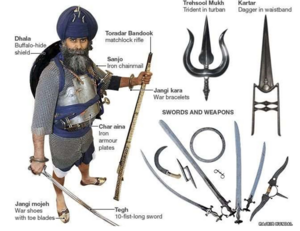Talk:Military Sports:Fencing or Swordsmanship and Mace Fight
By Vishal Agarwal and The Hindu Society of Minnesota
Indian steel was particularly renowned for sword making across the medieval world. Hindus made the best swords in the ancient world; they discovered the process of making Ukku steel, called Damascus steel by the rest of the world (Damas meaning water to the Arabs, because of the watery designs on the blade). These were the best swords in the ancient world— the strongest and the sharpest, sharper even than Japanese katanas. Romans, Greeks, Arabs, Persians, Turks, and Chinese imported it. The original Damascus steel—the world's first high-carbon steel—was a product of India known as wootz. Wootz is the English for ukku in Kannada and Telugu, meaning steel. Indian steel was used for making swords and armor in Persia and Arabia in ancient times. Ktesias at the court of Persia (5th c. BCE) mentions two swords made of Indian steel which the Persian king presented him. The pre-Islamic Arab word for sword is muhannad meaning from Hind. So famous were they that the Arabic word for sword was Hindvī — from Hind.
Princesses along with princes were also trained in these martial arts like swordsmanship, horse-riding, and archery.Itihāsa is replete with examples of warrior queens like Rāṇī Ceṇṇammā of Kittūr in Karnaṭaka (1778–1829 CE), Rāṇī Lakṣmībāī of Jhānsī (1835–1857 CE), and many others.
Maces were used as military weapons, and several battles involving maces by Hanumān, Bhīma, etc., are mentioned in the Rāmāyaṇa and the Mahābhārata. In more recent times, the Sikh armies used them on a large scale while fighting Muslim enemies. In fact, the traditional Rājapūta and art of Gatkā using various weapons is best preserved today in Sikh communities.

